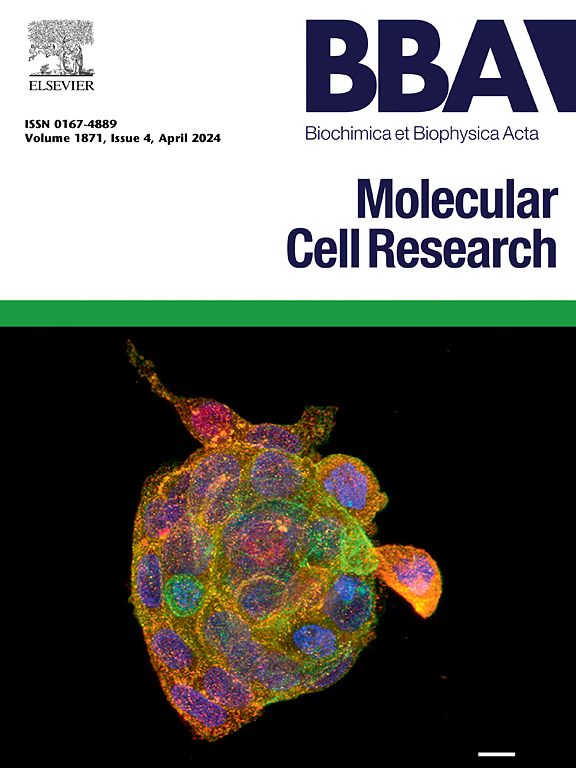ORAI1α和ORAI1β对细胞外pH值的敏感性不同。
IF 3.7
2区 生物学
Q1 BIOCHEMISTRY & MOLECULAR BIOLOGY
Biochimica et biophysica acta. Molecular cell research
Pub Date : 2025-06-21
DOI:10.1016/j.bbamcr.2025.120010
引用次数: 0
摘要
细胞外pH值降低在病理生理条件下很常见,包括神经系统疾病、炎症和癌症。与细胞外酸化一样,钙稳态失调与包括癌症在内的各种病理生理状态有关。pH的变化和钙的变化在理论上可以联系起来,因为几种钙转运蛋白的功能受到pH变化的影响。其中一个钙通道是ORAI1,细胞外pH值的变化调节门控。当内质网(ER)钙储存耗尽时,基质相互作用分子1 (STIM1)与ORAI1的偶联促进钙流入并重新填充内质网钙储存,这一过程被称为储存操作钙进入(SOCE)。据报道,ORAI1在包括基底乳腺癌在内的几种癌症类型中表达增加。ORAI1蛋白表达为两个变体,ORAI1α(长)和ORAI1β(短)。ORAI1α和ORAI1β的不同作用尚不完全清楚。先前的研究表明ORAI1的门控特性受到细胞内和细胞外pH变化的影响,但没有研究ORAI1α和ORAI1β变体对pH变化的敏感性是否存在差异。在这项研究中,我们使用基于细胞的钙通量测定来比较不同细胞外ph值下ORAI1α-和orai1 β介导的钙内流。我们开发了一个包含SOCE的细胞内钙动力学的数学模型来量化钙内流的变化。将该模型与我们的数据拟合显示,在pH 6.8时,与ORAI1β相比,ORAI1α与更持续的钙内流相关。ORAI1α n端点突变确定了pH值 6.8时ORAI1变异体差异激活的潜在结构域。本文章由计算机程序翻译,如有差异,请以英文原文为准。
ORAI1α and ORAI1β have differential sensitivity to extracellular pH
Reduction in extracellular pH is common in pathophysiological conditions including neurological disorders, inflammation, and cancer. Like extracellular acidification, dysregulated calcium homeostasis is linked to various pathophysiological states including cancer. Changes in pH and calcium can theoretically be linked since the function of several calcium transporters is affected by pH changes. One such calcium channel is ORAI1, where changes in extracellular pH modulate gating.
Upon depletion of the endoplasmic reticulum (ER) calcium store, coupling of stromal interacting molecule 1 (STIM1) with ORAI1 facilitates calcium influx and refills the ER calcium store, a process known as Store-Operated Calcium Entry (SOCE). ORAI1 expression has been reported to be increased in several cancer types including basal breast cancer. The ORAI1 protein is expressed as two variants, ORAI1α (long) and ORAI1β (short). The differential roles of ORAI1α and ORAI1β are still not fully understood. Previous studies have shown that ORAI1 gating properties are affected by both intracellular and extracellular pH changes, but none have investigated whether ORAI1α and ORAI1β variants differ in sensitivity to pH changes.
In this study, we used cell-based calcium flux assays to compare ORAI1α- and ORAI1β-mediated calcium influx at different extracellular pHs. We developed a mathematical model of intracellular calcium dynamics incorporating SOCE to quantify variations in calcium influx. Fitting this model to our data revealed that at pH 6.8, ORAI1α is associated with more sustained calcium influx compared to ORAI1β. Point mutations in the N-terminus of ORAI1α identified potential domains responsible for the differential activation of ORAI1 variants at pH 6.8.
求助全文
通过发布文献求助,成功后即可免费获取论文全文。
去求助
来源期刊
CiteScore
10.00
自引率
2.00%
发文量
151
审稿时长
44 days
期刊介绍:
BBA Molecular Cell Research focuses on understanding the mechanisms of cellular processes at the molecular level. These include aspects of cellular signaling, signal transduction, cell cycle, apoptosis, intracellular trafficking, secretory and endocytic pathways, biogenesis of cell organelles, cytoskeletal structures, cellular interactions, cell/tissue differentiation and cellular enzymology. Also included are studies at the interface between Cell Biology and Biophysics which apply for example novel imaging methods for characterizing cellular processes.

 求助内容:
求助内容: 应助结果提醒方式:
应助结果提醒方式:


